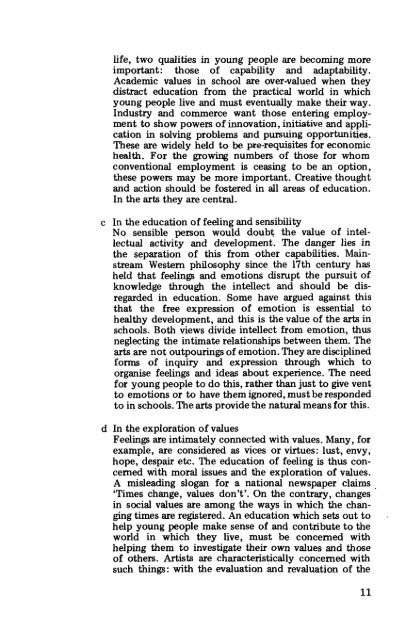The Arts in Schools - Calouste Gulbenkian Foundation
The Arts in Schools - Calouste Gulbenkian Foundation
The Arts in Schools - Calouste Gulbenkian Foundation
- No tags were found...
You also want an ePaper? Increase the reach of your titles
YUMPU automatically turns print PDFs into web optimized ePapers that Google loves.
life, two qualities <strong>in</strong> young people are becom<strong>in</strong>g moreimportant: those of capability and adaptability.Academic values <strong>in</strong> school are over-valued when theydistract education from the practical world <strong>in</strong> whichyoung people live and must eventually make their way.Industry and commerce want those enter<strong>in</strong>g employmentto show powers of <strong>in</strong>novation, <strong>in</strong>itiative and application<strong>in</strong> solv<strong>in</strong>g problems and pursu<strong>in</strong>g opportunities.<strong>The</strong>se are widely held to be pre-requisites for economichealth. For the grow<strong>in</strong>g numbers of those for whomconventional employment is ceas<strong>in</strong>g to be an option,these powers may be more important. Creative thoughtand action should be fostered <strong>in</strong> all areas of education.In the arts they are central.e In the education of feel<strong>in</strong>g and sensibilityNo sensible person would doubt the value of <strong>in</strong>tellectualactivity and development. <strong>The</strong> danger lies <strong>in</strong>the separation of this from other capabilities. Ma<strong>in</strong>streamWestern philosophy s<strong>in</strong>ce the 17th century hasheld that feel<strong>in</strong>gs and emotions disrupt the pursuit ofknowledge through the <strong>in</strong>tellect and should be disregarded<strong>in</strong> education. Some have argued aga<strong>in</strong>st thisthat the free expression of emotion is essential tohealthy development, and this is the value of the arts <strong>in</strong>schools. Both views divide <strong>in</strong>tellect from emotion, thusneglect<strong>in</strong>g the <strong>in</strong>timate relationships between them. <strong>The</strong>arts are not outpour<strong>in</strong>gs of emotion. <strong>The</strong>y are discipl<strong>in</strong>edforms of <strong>in</strong>quiry and expression through which toorganise feel<strong>in</strong>gs and ideas about experience. <strong>The</strong> needfor young people to do this, rather than just to give ventto emotions or to have them ignored, must be respondedto <strong>in</strong> schools. <strong>The</strong> arts provide the natural means for this.d In the exploration of valuesFeel<strong>in</strong>gs are <strong>in</strong>timately connected with values. Many, forexample, are considered as vices or virtues: lust, envy,hope, despair etc. <strong>The</strong> education of feel<strong>in</strong>g is thus concernedwith moral issues and the exploration of values.A mislead<strong>in</strong>g slogan for a national newspaper claims"Times change, values don't'. On the contrary, changes<strong>in</strong> social values are among the ways <strong>in</strong> which the chang<strong>in</strong>gtimes are registered. An education which sets out tohelp young people make sense of and contribute to theworld <strong>in</strong> which they live, must be concerned withhelp<strong>in</strong>g them to <strong>in</strong>vestigate their own values and thoseof others. Artists are characteristically concerned withsuch th<strong>in</strong>gs: with the evaluation and revaluation of the11
















